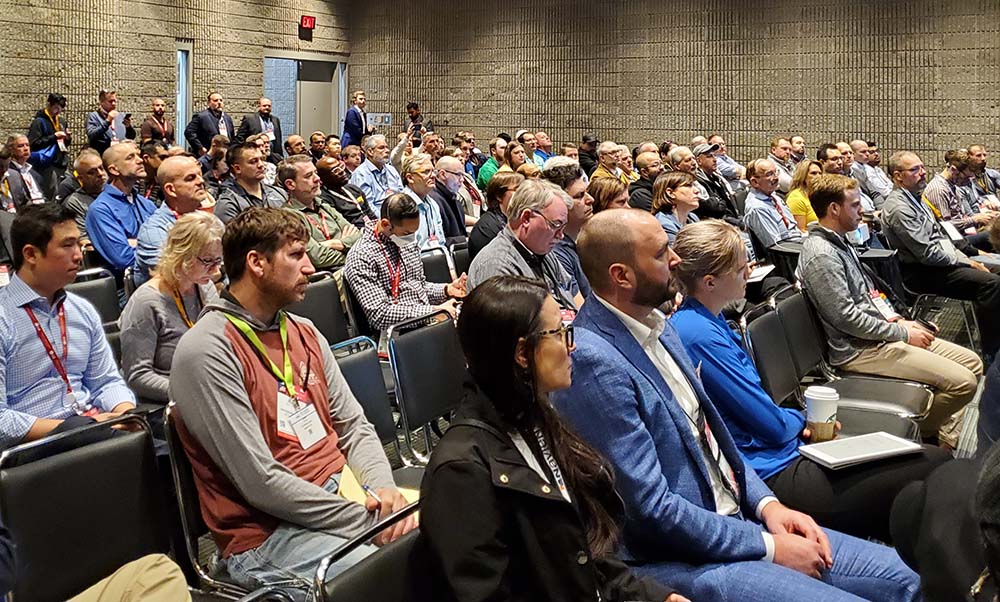Vice president of codes, standards and environmental affairs
Johnson Controls Inc.
Though HVACR in the U.S. has “regulations coming at us from every direction,” significant opportunities also abound, and new federal investment in climate protection and electrification will provide a huge boost to the industry.
That industry snapshot, from a regulatory standpoint, was provided by a top manufacturing executive during the AHR Expo in Atlanta in February.
Chris Forth, vice president of codes, standards and environmental affairs at Johnson Controls Inc., told a group of AHR attendees the industry can increase equipment installations with the help of the tax incentives and consumer rebates in the Inflation Reduction Act (IRA); turn government mandates, like energy-efficiency minimums and the transition to lower-GWP refrigerants, to its advantage; and rely more on improving technologies like cold-climate heat pumps as energy efficiency becomes a greater national priority.

LISTENING IN: There were only a few empty seats when Chris Forth, vice president of codes, standards and environmental affairs at Johnson Controls Inc., spoke to AHR Expo attendees on Feb. 7 in Atlanta. (Staff photo)
Forth called the IRA, which includes billions in incentives for electrification and high-efficiency products, the greatest-ever investment in HVAC. The IRA directs $369 billion toward energy security and fighting climate change — including by incentivizing energy efficiency, electrification, and renewable sources of electricity.
The IRA will “affect each and every one of you in this room in some way, shape, or form, either directly or indirectly,” Forth said.
“It’s many programs rolled up under this IRA umbrella. And it applies to everything: residential, commercial, multifamily,” as well as to different types of HVAC products and systems, he added.
The IRA’s coming rebate programs have not been completely detailed, however. “They’re going to hand those to the states to administer,” Forth said. “That means 50 states, 50 different programs — and six territories.”
The Department of Energy (DOE) late last year announced the allocations for each state of the more than $9.5 billion in rebate money the IRA sets aside for the purchase and installation of qualified HVAC equipment and for other energy-efficiency measures.
Contractors, Forth said, need to keep aware of what kinds of equipment qualifies for incentives. In some cases, he said, federal incentives may be combined with state or even utility company incentives to maximize consumers’ savings.
Contractors should also be aware of the area median incomes, or AMI, of the places in which they do business, he said, as some IRA rebates for qualified HVAC equipment have eligibility guidelines based on income. (Households with up to 150% of the AMI can get rebates in one HVAC program, while another program that applies to energy efficiency more broadly has no income limits.)
The IRA’s rebates are intended to be given at the point of sale, meaning consumers will instantly get discounts or cash back. Given that, Forth said, the industry is lobbying “in a positive way” for contractors to be quickly made whole, instead of having to wait for reimbursement from state governments.
“We’ve heard loud and clear from contractors: Contractors don’t want to be the one floating a loan,” Forth said. “In other words, ‘Hey, Mr. Homeowner, you got my equipment,’ and then they’re (the contractor) waiting 120 days for the government to pay them. So we want to try to avoid that.”
The transition to lower-GWP refrigerants, Forth said, will come just a few years after the adoption of the current generation of refrigerants, and will necessitate the introduction of new equipment lines.
“Every one of those will have to be launched with a new low-GWP refrigerant,” he said.
It will also mean, as the production of the higher-GWP refrigerant R-410A is phased out, that refrigerant reclamation will be vital for servicing R-410A equipment, for which no drop-in alternative refrigerant exists.
“No unicorn refrigerants,” Forth said. “The only alternative today is reclaim.” Reclaimed refrigerant is chemically identical to virgin refrigerant, he said.
Forth told contractors to “start saving your dirty gas” and build relationships with reclamation companies. “If you’re not in that business, this is one of those opportunities,” he said.
The adoption of lower-GWP, low-flammability, or A2L, refrigerants, Forth said, will require new handling and transportation procedures, but A2Ls have only “a few degrees of difference” from current refrigerants in terms of flammability.
“So let’s everybody calm down,” he said. “We’re not going to propane yet.”
Other points made by Forth during his hour-long presentation included:
- While industry regulations once centered on energy efficiency, they now touch on issues like IAQ, refrigerant GWP, and even the single-use plastics that go into product packaging. Companies, he said, are making changes to meet environmental, sustainability, and governance commitments.
“These things are all going to drive our business in a very exponential way,” he said. “And I will say that, for us, it’s a good problem to have.” - Heat-pump technology has greatly improved, as the machines are able to gather more heat from the outdoors, even in colder temperatures. However, “We don’t ever advocate putting in (a) heat pump, cold-climate or not, without some form of backup heat,” Forth said.
- The electrification movement will require changes to building electrical systems, for which the IRA also provides incentives.
“If you don’t have a partnership with (an) electrician, electrical company, you might want to get one,” Forth said. “All these heat pumps will require panel upgrades.” - Ensuring energy efficiency remains the most significant way to reduce harmful carbon emissions.
“We as an industry will be putting in much higher-energy-efficiency equipment,” he said.



Report Abusive Comment